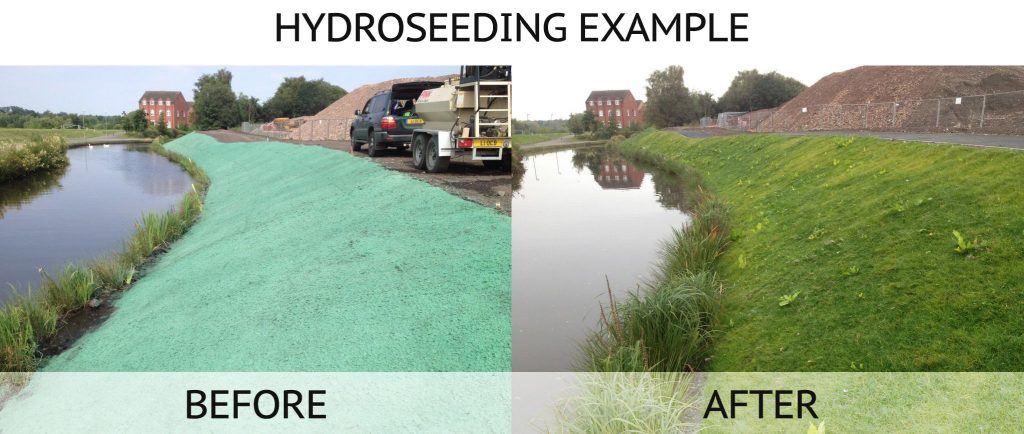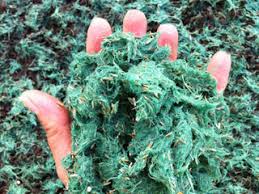Hydroseeding and hydromulching are two popular techniques used for soil stabilization, ground cover, and erosion control. While they might seem similar at first glance, each method has its unique characteristics and applications. Understanding the differences between hydroseeding and hydromulching can help you choose the most suitable option for your landscaping or land reclamation project.
In this article, we will delve into the distinctions between hydroseeding and hydromulching, their respective advantages, and the scenarios in which each method is most effective.
Hydroseeding: An Overview

Hydroseeding, also known as hydraulic mulch seeding, is a planting process that uses a slurry of seeds, mulch, fertilizers, and water. This mixture is sprayed over prepared ground using specialized equipment. Hydroseeding is commonly used for establishing lawns, pastures, and other large areas of vegetation quickly and efficiently.
How Does Hydroseeding Work?
The hydroseeding process begins with the preparation of the slurry. The components are mixed in a hydroseeder tank, which agitates the mixture to ensure even distribution. Once the slurry is ready, it is sprayed onto the soil using a hose or a cannon. The mulch in the mixture helps retain moisture, protect seeds from erosion, and provide a conducive environment for germination.
Advantages of Hydroseeding
Hydroseeding offers several benefits, making it a popular choice for various landscaping and reclamation projects:
- Cost-effective: Compared to traditional sod installation, hydroseeding is more affordable, especially for large areas.
- Quick Application: The spraying process allows for the fast and uniform distribution of seeds over extensive areas.
- Erosion Control: The mulch in the slurry helps prevent soil erosion and protects the seeds from being washed away by rain or irrigation.
- Customization: The slurry can be tailored to suit specific soil conditions, seed types, and project requirements.
Hydromulching: An Overview

Hydromulching is a technique similar to hydroseeding but focuses more on erosion control and soil stabilization. It involves the application of a thick slurry containing mulch, tackifiers, and other additives to create a protective layer over the soil. While seeds can be included in the mixture, hydromulching is often used without them in situations where immediate soil stabilization is the primary goal.
How Does Hydromulching Work?
The hydromulching process is akin to hydroseeding, with the slurry being mixed in a specialized tank and sprayed onto the soil. However, the composition of the slurry is different. Hydromulching slurry typically contains a higher concentration of mulch and tackifiers, which help the mixture adhere to the soil and form a protective barrier.
Advantages of Hydromulching
Hydromulching is particularly effective in scenarios where soil stabilization and erosion control are paramount. Here are some key benefits:
- Enhanced Erosion Control: The thicker mulch layer provides superior protection against erosion caused by wind and water.
- Immediate Soil Stabilization: Hydromulching is ideal for stabilizing slopes, construction sites, and other areas prone to erosion.
- Versatility: The slurry composition can be adjusted to include seeds, fertilizers, and other additives based on project needs.
- Cost-effective: Hydromulching can be more economical than installing erosion control blankets or other mechanical stabilization methods.
Hydroseeding vs. Hydromulching: Key Differences
While hydroseeding and hydromulching share similarities, several key differences set them apart:
Purpose and Application
- Hydroseeding: Primarily used for planting and establishing vegetation quickly. Ideal for lawns, pastures, and large green spaces.
- Hydromulching: Focuses on soil stabilization and erosion control. Commonly used on slopes, construction sites, and areas requiring immediate soil protection.
Slurry Composition
- Hydroseeding: Contains seeds, mulch, fertilizers, and water. The emphasis is on promoting seed germination and growth.
- Hydromulching: Contains a higher concentration of mulch and tackifiers, with or without seeds. The focus is on creating a protective layer over the soil.
Mulch Thickness
- Hydroseeding: The mulch layer is relatively thin, sufficient to protect seeds and retain moisture.
- Hydromulching: The mulch layer is thicker, providing enhanced erosion control and soil stabilization.
Cost
- Hydroseeding: Generally more cost-effective for establishing vegetation over large areas.
- Hydromulching: May be more economical for immediate soil stabilization and erosion control compared to other mechanical methods.
Equipment
- Hydroseeding: Uses hydroseeder equipment with tanks for mixing and spraying the slurry.
- Hydromulching: Uses similar equipment but may require specialized tanks for handling thicker slurry mixtures.
Choosing Between Hydroseeding and Hydromulching
The choice between hydroseeding and hydromulching depends on the specific needs of your project. Here are some factors to consider:
Project Goals
- Vegetation Establishment: If your primary goal is to establish grass or other vegetation quickly, hydroseeding is the better choice.
- Soil Stabilization: For immediate erosion control and soil stabilization, hydromulching is more suitable.
Site Conditions
- Large, Flat Areas: Hydroseeding works well for large, relatively flat areas where erosion is not a significant concern.
- Slopes and Erosion-Prone Areas: Hydromulching is ideal for slopes, construction sites, and areas vulnerable to erosion.
Budget
- Cost Considerations: Hydroseeding is generally more cost-effective for large-scale planting projects. Hydromulching can be more economical for erosion control compared to mechanical methods.
Timeframe
- Immediate Results: Hydromulching provides immediate soil stabilization, making it suitable for projects with urgent erosion control needs.
- Gradual Growth: Hydroseeding offers a cost-effective solution for gradual vegetation growth over time.
Conclusion
Both hydroseeding and hydromulching are valuable techniques for soil stabilization, ground cover, and erosion control. Understanding the differences between the two methods can help you make an informed decision based on your project’s specific requirements. Whether you need to establish vegetation quickly or stabilize soil immediately, choosing the right technique will ensure the success of your landscaping or land reclamation project.
By considering factors such as project goals, site conditions, budget, and timeframe, you can select the most suitable method and achieve the desired outcomes.








Leave a Reply
You must be logged in to post a comment.